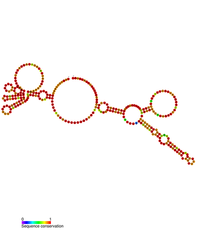Rous sarcoma virus
| Rous sarcoma virus | |
|---|---|
| Virus classification | |
| Group: | Group VI (ssRNA-RT) |
| Order: | Unassigned |
| Family: | Retroviridae |
| Subfamily: | Orthoretrovirinae |
| Genus: | Alpharetrovirus |
| Species: | Rous sarcoma virus |
| Retroviral 3'UTR stability element | |
|---|---|

Predicted secondary structure of the Rous sarcoma virus retroviral 3'UTR stability element
|
|
| Identifiers | |
| Rfam | RF01417 |
| Other data | |
| RNA type | Cis-reg |
| SO | {{{SO}}} |
Rous sarcoma virus (RSV) (/raʊs/) is a retrovirus and is the first oncovirus to have been described: it causes sarcoma in chickens.
As with all retroviruses, it reverse transcribes its RNA genome into cDNA before integration into the host DNA.
RSV was discovered in 1911 by Peyton Rous, working at Rockefeller University in New York City, by injecting cell free extract of chicken tumour into healthy Plymouth Rock chickens. The extract was found to induce oncogenesis. The tumour was found to be composed of connective tissue (a sarcoma). Thus, RSV became known as the first oncogenic retrovirus that could be used to study the development of cancer molecularly.
In 1958, Harry Rubin and Howard Temin developed an assay where chicken embryo fibroblasts could be altered morphologically by RSV infection. Two years later Temin concluded that the transformed morphology of the cells was controlled by a genetic property of RSV. At that time it was unknown, but later the src gene was identified as responsible for morphological transformation in healthy cells. During the 1960s, two findings emerged: replication-competent isolated viruses were related to RSV, but were non-transforming, and an isolated replication-defective strain of RSV was transformation-competent. These two findings gave rise to the notion that viral replication and malignant transformation are separate processes in RSV.
Rous was awarded the Nobel Prize in Physiology or Medicine for the significance of his discovery in 1966. Subsequently after, other oncogenic human viruses, such as Epstein-Barr virus were discovered. Furthermore, oncogenes were found initially in retroviruses and then in cells.
RSV is a class VI enveloped virus with a positive sense RNA genome having a DNA intermediate.
RSV has four genes:
The RSV genome has terminal repeats enabling its integration into the host genome and also overexpression of RSV genes.
...
Wikipedia
